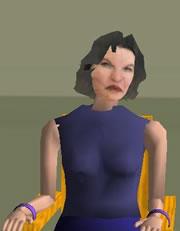 Mel Slater
Mel SlaterResearchers have recreated in a virtual world one of the most extreme social experiments ever performed in the real world. The results suggest that virtual environments could provide a way to explore human nature in ways that ethical concerns could make impossible to do for real.
Mel Slater, who works jointly at the Catalan Polytechnic University in Barcelona, Spain, and at University College London, UK, and his colleagues set up a virtual version of an infamous experiment on obedience to authority.
In the original experiment, conducted by Stanley Milgram in the 1960s, volunteers were told by an authority figure to deliver electric shocks to another person as punishment for incorrect answers to a test1. The other person wasn’t really receiving the shocks, but the volunteers were tricked into thinking they were by shouts of pain and protest. Despite this feedback, some volunteers went on to deliver what would have been lethal shocks.
Slater’s volunteers did a similar experiment, but in an immersive virtual environment where they interacted with a virtual woman. This counters some of the ethical protests that have prevented Milgram’s experiment from being repeated because the volunteers knew they would be interacting with a virtual woman and so, unlike Milgram’s guinea-pigs, knew that nobody was being hurt.
Ramping up
Half the volunteers could see the woman and half could not, communicating with her only through text. Both were told to give her ‘electric shocks’ of increasing voltage when she gave incorrect answers to test questions. The woman responded to these with protests and discomfort, asking for the test to stop as the voltage was ramped up.
The group from whom the virtual woman was hidden delivered shocks up to the maximum voltage, like many of those in Milgram’s experiment. Those who could see her were more likely to stop before reaching this limit2.
Almost half of those who could see the woman said afterwards that they had considered withdrawing from the study, and several actually did. “Of course, consciously everybody knows nothing is happening,” says Slater. “But some parts of the person’s perceptual system just takes it as real. Some part of the brain doesn’t know about virtual reality.”
And instead of becoming accustomed to the virtual person and ceasing to empathise, many volunteers became more anxious as the study continued. Measures of stress, such as heart rate and sweatiness of palms, increased. These measures are nearly impossible to fake, and confirmed for Slater that the volunteers were actually feeling uncomfortable, rather than performing as they thought the experimenter would expect.
Virtual experiment
The authenticity of the experience could give scientists new ways to test their theories about extreme social situations. It might also allow them to revisit other notorious studies, such as The Stanford Prison Experiment of the 1970s, in which students playing the role of guards became abusive towards their play-acting prisoners, with distressing consequences.
“They’re opening Pandora’s Box again — in a good way,” says Jeremy Bailenson, who researches interaction in virtual environments at Stanford University in California. “What Slater’s research is showing is if you make your virtual reality good enough, you can go back and ask all these questions”.
Slater himself hopes to use virtual environments to investigate why crowds of people stand by and watch an act of violence without intervening — the so-called bystander effect.
ADVERTISEMENT
But some suggest that there are still ethical problems to think about, even in a virtual world. William Dutton at Oxford University’s Internet Institute in the United Kingdom says that researchers need to think about how the participants react. “People may still be affected by the fact that they did these things — it’s just as much an ethical issue in a virtual environment.”
Slater disagrees. “People were perfectly able to stop whenever they want. They were saying to themselves, ‘I’m only carrying on because I know it’s not real’. Why virtual reality is so good here is that you get the automatic body responses of anxiety and so on, but there’s still that distance — it isn’t real.”
Visit our realityshocker.html">newsblog to read and post comments about this story.
